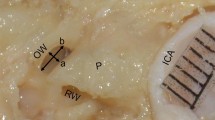Abstract
Purpose
The surgical treatment of otosclerosis can be challenging in case of anatomical abnormalities or variations of the oval window niche (OWN) area, as in very narrow OWN or in an overhanging facial nerve. The aim of the present study was to explore the role of endoscopic stapes surgery in cases with difficult OWN anatomy.
Methods
Patients undergoing endoscopic stapes surgery from 2008 to 2017, which fulfilled the CT scan criteria for a “difficult” anatomical condition, according to the measurements and cut-off values defined in the literature, were retrospectively selected. The intraoperative endoscopic view of the anatomical details and surgical difficulties were analysed through the review of the operative videos. Finally, a statistical analysis of the relationship between endoscopic visualization of anatomical details and radiological measurements was carried out.
Results
Eighteen out of 205 patients (8.7%) were included in the study. The 94.4% of patients obtained an optimal endoscopic exposure and visualization of all the anatomical details considered in the study, during each step of stapes surgery. The OWN measurements (width, depth and facial–promontory angle) did not affect significantly the endoscopic surgical exposure of the footplate or any of the other anatomical details.
Conclusions
The anatomic features of the oval window area which reduce the visualization in microscopic surgery, did not affect the surgical exposure in endoscopic stapes surgery. Patients having a difficult anatomy of the OWN can be treated safely with the endoscopic approach. In the case of a predicted “difficult anatomy”, the endoscopic approach can be considered a viable option.




Similar content being viewed by others
References
Vincent R, Sperling NM, Oates J, Jindal M (2006) Surgical findings and long-term hearing results in 3,050 stapedotomies for primary otosclerosis: a prospective study with the otology-neurotology database. Otol Neurotol 27(8 Suppl 2):S25–S47
Fisch U, May J (1994) Tympanoplasty, mastoidectomy, and stapes surgery. Thieme, New York
Lippy WH, Berenholz LP, Schuring AG et al (2002) Promontory drilling in stapedectomy. Otol Neurotol 23(4):439–441
Ayache D, Sleiman J, Tchuente AN, Elbaz P (1999) Variations and incidents encountered during stapes surgery for otosclerosis. Ann Oto-Laryngol Chir Cervico Fac 116(1):8–14
Nemati S, Ebrahim N, Kaemnejad E, Aghjanpour M, Abdollahi O (2013) Middle ear exploration results in suspected otosclerosis cases: are ossicular and footplate area anomalies rare? Iran J Otorhinolaryngol 25(72):155–160
Cao Y, Li D (1996) Facial canal dehiscence: a report of 1,465 stapes operations. Ann Otol Rhinol Laryngol 105(6):467–471
Daniels RL, Krieger LW, Lippy WH (2001) The other ear: findings and results in 1,800 bilateral stapedectomies. Otol Neurotol 22(5):603–607
Di Martino E, Sellhaus B, Haensel J et al (2005) Fallopian canal dehiscences: a survey of clinical and anatomical findings. Eur Arch Oto-Rhino-Laryngol 262(2):120–126
Parra C, Trunet S, Granger B et al (2017) Imaging criteria to predict surgical difficulties during stapes surgery. Otol Neurotol 38(6):815–821
Ukkola-Pons E, Ayache D, Pons Y, Ratajczak M, Nioche C, Williams M (2013) Oval window niche height: quantitative evaluation with CT before stapes surgery for otosclerosis. AJNR Am J Neuroradiol 34(5):1082–1085
Veillon F, Riehm S, Emachescu B et al (2001) Imaging of the windows of the temporal bone. Semin Ultrasound CT MR 22(3):271–280
Lagleyre S, Sorrentino T, Calmels M-N et al (2009) Reliability of high-resolution CT scan in diagnosis of otosclerosis. Otol Neurotol 30(8):1152–1159
Marchioni D, Soloperto D, Villari D et al (2016) Stapes malformations: the contribute of the endoscopy for diagnosis and surgery. Eur Arch Oto-Rhino-Laryngol 273(7):1723–1729
Nogueira JF, Mattioli F, Presutti L, Marchioni D (2013) Endoscopic anatomy of the retrotympanum. Otolaryngol Clin North Am 46(2):179–188
Gristwood RE, Bedson J (2008) Observations on bilateral symmetry of the stapedial footplate lesion and narrowing of the oval window niche in otosclerosis. Ann Otol Rhinol Laryngol 117(8):569–573
Gurgel RK, Jackler RK, Dobie RA, Popelka GR (2012) A new standardized format for reporting hearing outcome in clinical trials. Otolaryngol Head Neck Surg 147(5):803–807
Inserra MM, Mason TP, Yoon PJ, Roberson JB (2004) Partial promontory technique in stapedotomy cases with narrow niche. Otol Neurotol 25(4):443–446
Saunders NC, Fagan PA (2006) Promontory drilling in stapedectomy: an anatomical study. Otol Neurotol 27(6):776–780
Brackmann D, Clough S, Moses A (2009) Otologic surgery, 3rd edn. Saunders, Philadelphia, 864 p
Hunter JB, Rivas A (2016) Outcomes following endoscopic stapes surgery. Otolaryngol Clin North Am 49(5):1215–1225
Sproat R, Yiannakis C, Iyer A (2017) Endoscopic stapes surgery: a comparison with microscopic surgery. Otol Neurotol 38(5):662–666
Author information
Authors and Affiliations
Corresponding author
Ethics declarations
Conflict of interest
All the authors approved the manuscript. The authors have no financial disclosures or conflict of interest.
Additional information
Publisher’s Note
Springer Nature remains neutral with regard to jurisdictional claims in published maps and institutional affiliations.
Rights and permissions
About this article
Cite this article
Fernandez, I.J., Bonali, M., Fermi, M. et al. The role of endoscopic stapes surgery in difficult oval window niche anatomy. Eur Arch Otorhinolaryngol 276, 1897–1905 (2019). https://doi.org/10.1007/s00405-019-05401-z
Received:
Accepted:
Published:
Issue Date:
DOI: https://doi.org/10.1007/s00405-019-05401-z




